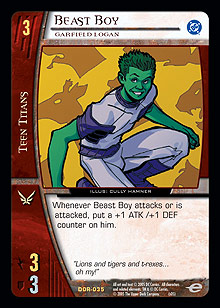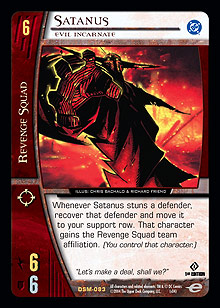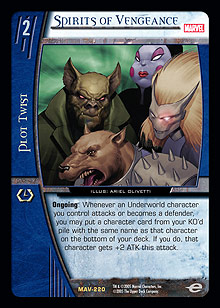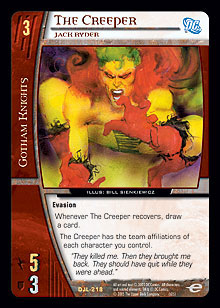
Hi All,
As is customary around this time of the season, it’s time to clear all the questions out of my inbox to make way for the avalanche of New Expansion Hotness that’s starting this weekend! Please send all your rules questions in to vsrules@gmail.com.
Are cards like Zatanna, Nth Metal, and Metamorpho supposed to trigger once for each attacker or not?
Steve L.
Until the X-Men rules update goes live, the rules say they do. Once that update goes live, it will say:
 Powers that trigger when a character “defends” or “becomes a defender” will trigger only once per character that becomes a defender.
Powers that trigger when a character “defends” or “becomes a defender” will trigger only once per character that becomes a defender.
In other words, “defends” and “becomes a defender” will mean exactly the same thing.
To answer another question I’ve seen asked on the subject, this doesn’t change how cards like Beast Boy work. His current text is:
Whenever Beast Boy attacks, put a +1 ATK / +1 DEF counter on him.
Whenever Beast Boy becomes a defender, put a +1 ATK / +1 DEF counter on him for each attacker.
The key words are “for each attacker.” If Beast Boy defends against multiple attackers, he gets multiple counters. But if Zatanna (with cosmic counter) defends against multiple attackers, she powers-up only once.
Playing with some friends the other day, we ran into a couple of Secret Society questions. The first one involves Gorilla City. Do you need to have a legal target to activate it and put a card into your KO’d pile?
Steve L.
Yes. Since it uses the word “target,” you can’t play the effect unless there is a “Secret Society attacker you control” to target.
The second question was with regards to the new Poison Ivy, Kiss of Death. She stole a 2-drop from an opponent, and later in the game, that character got KO’d. Initially, the Poison Ivy player put the card into his own KO’d pile. I ruled that the card would be put into its owner’s KO’d pile. Is that the correct ruling?
Steve L.
Yep. If a card changes zones and goes to a KO’d pile, it goes to its owner’s KO’d pile.
I control Satanus and a couple other characters. My friend controls Spider-Man, Peter Parker, which reads, “Pay 1 endurance >>> Stunned Spider-Friends characters you control cannot be the target of effects your opponents control this turn.” If my friend uses this power, and then a team attack involving Satanus stuns Spidey, can I recover him and move him to my support row? Or does Satanus’s power do nothing?
Saige C.
 If your friend pays 1 endurance before Spidey becomes stunned, then Spidey is protected by the resulting modifier while stunned.
If your friend pays 1 endurance before Spidey becomes stunned, then Spidey is protected by the resulting modifier while stunned.
However, that modifier does not protect him from Satanus’s triggered effect, because that effect does not use the word “target.” “Target” means something very particular in Vs. System, and if an effect on a card doesn’t use the word “target,” then that effect doesn’t target.
As a result, Spidey recovers and moves to your support row.
I have a simple question, and I just want to be certain we are playing correctly. Using a simple example, Gorilla Grodd uses his power to KO a ready character adjacent to him with a cost of X. That character is put into your KO’d pile. Do you lose X endurance due to the KO, or 0 endurance because the character was not stunned? We have always assumed 0, but I just wanted to be sure.
Colby D.
Yep, that’s right. The endurance loss you’re asking about is called stun endurance loss. If a character is KO’d, its controller does not take any stun endurance loss.
I have two questions about the same situation. My opponent activates Alfred Pennyworth to search for a card. In response, I use Oliver Queen ◊ Green Arrow, Emerald Archer to KO him. In response to that, my opponent tries to recruit a Utility Belt and use it. First question: Can he chain the recruit of Utility Belt to Oliver’s effect? I have been told that you can’t chain a recruit to an effect.
Andrew M.
That’s correct, you can’t. You can only play a recruit effect when the chain is empty.
Second question: In order to pay the cost of Alfred’s effect, he is returned to hand, so can I even KO him with Oliver in this manner?
Andrew M.
No. As you say, he is returned to hand as a cost. By the time you get priority to play Oliver’s effect, Alfred is no longer a legal target.
I was looking at Jason Todd ◊ Robin and just wanted clarification that his effect resolves like Heroic Sacrifice. Can I exhaust an already exhausted defender? I assume I can, as it is part of resolution and not a cost to play the card. Once the cost has been paid, will it try to resolve as much as possible by not being able to exhaust but still ending the attack?
Zac O.
You’re correct that you can try to exhaust an already exhausted defender. However, it’s worth clarifying that removing the last attacker doesn’t immediately end an attack. Even if there are no attackers and/or defenders remaining, both players have to pass on an empty chain before an attack concludes.
I play Injustice Gang and I was wondering if I could use Power Siphon on a character that’s already exhausted. As far as I know, I can still play it, but the character just can’t exhaust. It still gets the DEF buff, right?
Andrew P.
Well yes, you can still play it, because it doesn’t target a “ready Injustice Gang defender you control.”
But no, you won’t get the DEF buff, because that part of the effect follows the words “if you do.” If the target is not ready as the effect resolves, then you can’t exhaust it, so the rest of the effect does nothing.
Could I use Fifth Dimension with Lex Luthor, Nefarious Philanthropist to get two copies of Lex into play at once? Because it says, “put that character into your front row,” it doesn’t check for uniqueness, correct?
Andrew P.
That’s correct. The uniqueness rule is checked only while resolving a recruit effect (or flipping a location) and never at any other time.
Since Fifth Dimension has a cost of 4, the earliest you could typically get a second Lex into play would be the draw phase of the fifth turn, but it’s certainly possible!
If I were to use Spirits of Vengeance and had more than one copy face up, would the effects from all of them trigger off of one card being put on the bottom of my deck?
Andrew P.
 Let’s say you have two copies of Spirits of Vengeance face up in your resource row, and an Underworld character you control (Blackout, for example) attacks.
Let’s say you have two copies of Spirits of Vengeance face up in your resource row, and an Underworld character you control (Blackout, for example) attacks.
Two triggered effects go on the chain, both of which say “you may put a character card from your KO’d pile with the name Blackout on the bottom of your deck. If you do, Blackout gets +2 ATK this attack.”
If you have only one character card named Blackout in your KO’d pile, you may choose to put that card on the bottom of your deck only once, giving Blackout +2 ATK this attack. The other triggered effect will resolve but do nothing.
If you have two character cards named Blackout in your KO’d pile, you may choose to put them both on the bottom of your deck, one for each effect that resolves. Blackout will get +2 ATK from each resolution, for a total of +4 ATK this attack.
I have three questions today. The first one is a timing issue. My opponent controls Puppet Master and Rogue, Power Absorption, and I control Blackfire and have the initiative. At the start of the combat phase, Rogue copies Puppet Master. We both pass. My first question is, since we both pass, does this end the pre–attack step part of the combat phase, since there are no more effects on the chain?
Stewart M.
Well, the full sequence in all its glory looks like this:
- The combat phase starts, triggering Rogue’s power
- Just before you get priority, Rogue’s effect goes on the chain targeting Puppet Master
- You get priority, pass to the opponent, and the opponent passes
- Rogue’s effect resolves, “absorbing” Puppet Master’s activated power
- You get priority, pass to the opponent, and the opponent passes
- Your attack step begins
So, the first time you both pass (step 3), Rogue’s triggered effect resolves. It’s not until you both pass on an empty chain (step 5) that your attack step begins.
My opponent then activates Rogue to exhaust Blackfire. In response, I activate Blackfire to stun a front row character, claiming that it was my attack step. He says I can’t because we’re at the priority point between the start of the combat phase and my attack step. Who’s right?
Stewart M.
This is more of a communication question than a rules question. Just saying, “pass” often doesn’t make it clear exactly what you’re passing on. To remove all doubt, your opponent should optimally say something like, “Before your attack step, I’d like to activate Rogue.”
He’s correct that he can indeed activate Rogue at step 5 above instead of passing. If he does, then you can’t respond with Blackfire’s effect because it’s not yet your attack step. If, however, your opponent passes at step 5, then you enter your attack step and Blackfire’s effect becomes a legal response to Puppet Master’s.
Third question: My opponent controls Mr. Fantastic, Stretch, two Flamethrowers, and several other Fantastic Four characters. He moves one Flamethrower around, exhausting each character he controls during the build phase on turn 5. He then plays Cosmic Radiation to ready them all and proceeds to use the second Flamethrower on all of them. Since Flamethrower’s text reads “use this power only once per turn,” is it legal for him to use two Flamethrowers in this manner?
Stewart M.
 Nope. It’s not even legal for him to use one Flamethrower in this manner!
Nope. It’s not even legal for him to use one Flamethrower in this manner!
Flamethrower is specifically written to prevent this kind of shenanigan, because each Flamethrower itself has a power that can be used only once per turn, not each character it equips. So, if you exhaust Character1 to use Flamethrower1, then no other character can be exhausted to use Flamethrower1 that turn.
Interestingly, if you somehow get an unused Flamethrower2 onto a ready Character1 after exhausting that character to use Flamethrower1, then you can actually exhaust Character1 again to use Flamethrower2. If you really, really want to.
I was wondering if you could help me streamline some thought processes. Let’s say I play Unmasked so you can’t power-up the Brotherhood characters you want to stomp me with. Can you still use Lost City to give them +3 ATK / +3 DEF?
Lee B.
Here’s how it works: When Unmasked resolves, it creates a continuous modifier that effectively says “any power-up modifiers that would apply to a character this turn do nothing.”
A player may still play a power-up effect (discarding a character card of the same name, or activating Tamaran, or whatever) and that effect will still resolve and create a power-up modifier. But that modifier will do nothing to a character if Unmasked resolved earlier that turn.
Lost City replaces power-up events. If characters cannot become powered-up due to Unmasked, then there will be no power-up events for Lost City to replace.
So, in summary, characters that would be powered-up get neither +1 ATK / +1 DEF nor +3 ATK / +3 DEF if Unmasked resolved earlier that turn.
To conclude, here’s a trio of questions gathered from walking the floor at some recent tournaments:
If my opponent controls Lex Luthor, Nefarious Philanthropist and I play one or more plot twists before my build phase, why can’t I play one more after Lex’s triggered effect resolves? How is his modifier able to “remember” what I played before it was even created?
The key to understanding Lex’s modifier is listening to the “question” it asks.
Whenever an opponent attempts to play a plot twist after Lex’s triggered effect resolves, the modifier doesn’t ask, “Has this opponent played one or more plot twists since I was created?” It simply asks, “Has this opponent played one or more plot twists this turn?”
If an opponent has played one or more plot twists this turn, regardless of whether the opponent played them before or after Lex’s modifier was created, then that opponent fails the modifier’s test and is prevented from playing any more plot twists for the duration of the modifier.
Can I evade with The Creeper twice in one turn to draw two cards?
It’s certainly possible, although you don’t actually draw the second card in the same turn.
 If you start by evading before the recovery phase, the modifier created by the evasion will recover The Creeper at the start of the recovery phase, triggering his power and drawing you a card. Then, if you evade a second time during the recovery phase, you can recover The Creeper as your one-character-per-turn during the wrap-up. This triggers The Creeper’s power again, but because no player gets priority during the wrap-up, the effect doesn’t go on the chain until next turn’s draw phase. Two things to remember:
If you start by evading before the recovery phase, the modifier created by the evasion will recover The Creeper at the start of the recovery phase, triggering his power and drawing you a card. Then, if you evade a second time during the recovery phase, you can recover The Creeper as your one-character-per-turn during the wrap-up. This triggers The Creeper’s power again, but because no player gets priority during the wrap-up, the effect doesn’t go on the chain until next turn’s draw phase. Two things to remember:
- The Creeper needs to have evaded earlier in the turn in order to “evade-recover” at the start of the recovery phase. He won’t do so if he became stunned in an attack conclusion.
- If you choose The Creeper to be your one-character-per-turn to “wrap-up recover,” any other stunned characters you control are KO’d.
Can John Henry Irons ◊ Steel, Steel-Drivin’ Man KO an equipment equipped to a stunned character to power-up an attacker or defender you control?
Yep, that works fine. You still control equipment equipped to a stunned character.
Thus ends the last Cerebro before the X-Men return! As you read this, I’ll probably be prowling the floors of a Sneak Peek tournament or four, gleefully scribbling down every question I’m asked. Hope you all have even more fun at yours!